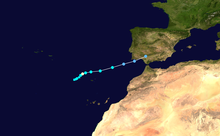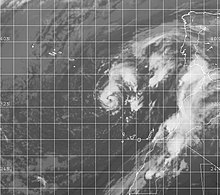Hurricane Vince
| Category 1 hurricane ( SSHWS ) | ||
|---|---|---|
| Hurricane Vince on October 9, 14:23 UTC | ||
| Emergence | October 8, 2005 | |
| resolution | October 11, 2005 | |
|
Peak wind speed |
|
|
| Lowest air pressure | 988 mbar ( hPa ; 29.2 inHg ) | |
| dead | not reported | |
| Property damage | Unknown | |
|
Affected areas |
Madeira , southern Portugal , southwestern Spain | |
| Season overview: Atlantic hurricane season 2005 |
||
Hurricane Vince was one of the rare hurricanes that were observed off the coasts of Southern Europe and North Africa . It was the 20th named storm and the eleventh hurricane of 2005. Hurricane Vince emerged as a storm low in the eastern Atlantic in early October 2005 and unexpectedly reached the Iberian Peninsula on October 11 as a tropical storm. On the one hand, Vince was a rather weak and short-lived hurricane, from which no major damage was reported, on the other hand, it was one of the most unusual hurricanes that were ever recorded in the Atlantic. It was the first hurricane to hit the Spanish coast in over 160 years. The last time a Category 2 hurricane hit the Iberian Peninsula was in October 1842.
Vince was the first hurricane to be named with the first letter "V" since the beginning of the naming of cyclones in 1950 and until 2019 the most easterly hurricane ever registered in the Atlantic. It was formed east of the 20th degree of longitude and north of the 30th parallel, which is an extraordinary record.
course
The formation and classification of Vince was viewed by meteorologists as quite controversial. When the initially unnamed 20th tropical low pressure area of the year showed the characteristics of a typical hurricane with a clear eye in the midst of a compact cloud system on October 8 at around 11 p.m. CEST, the American National Hurrican Center decided not to classify the system as a tropical storm, because the water temperature was actually too low for a hurricane to develop. Contrary to the previous assumption that hurricanes only occur at water temperatures above 26.5 ° C, Vince developed at water temperatures below 24 ° C.
Originally the storm was judged to be a subtropical rather than a tropical storm, but Vince ended up showing many of the characteristics of a tropical storm. So far it has been assumed that the development was favored by unusually cold arctic air masses at high altitude and that low water temperatures are sufficient under these circumstances. From the normal westerly wind zone, at an altitude of around 5500 meters ( 500 hPa level ), a small low altitude had sheared out and migrated to the Azores. An altitude low is coupled with cold air in higher air layers. So here the critical vertical temperature difference was not reached by strong heating from below, but by cooling from above. The convection that formed in the area of this low altitude was so strong that a hurricane-like system formed. In this form of formation, the low resembles a Medicane of the Mediterranean area rather than an Atlantic hurricane, as well as its trajectory: It was still influenced by the extra-tropical west wind drift , not the tropical trade winds , and therefore turned eastward.
The tropical storm Vince was officially named on October 9th at 17:00 CEST when it was in a rather unusual position in the eastern Atlantic near the island of Madeira , approximately 830 kilometers southeast of the Azores . Just six hours later, Vince was upgraded as a hurricane.
Vince reached mainland Europe on October 11th around 11:00 CEST near the Spanish city of Huelva after the cyclone weakened to the strength of a storm low.
Effects
“Vince” caused heavier rainfall on Madeira, the Canary Islands and also on the coasts of Portugal and Spain . No known damage to people or property was caused by Hurricane Vince. The highest recorded wind speed was 77 km / h in Jerez , Spain, although some ships reported stronger winds. Rainfall associated with Vince was comparable to normal rainfall events from non-tropical systems and ranged from 25-50 mm. In a pun on a song title from My Fair Lady , National Hurricane Center hurricane expert James Franklin commented in his report on Hurricane Vince, "the rain in Spain was mainly less than 2 inches, although 3.30 inches fell in the plain at Cordoba." In English: The rain in Spain was less than 50 mm, although 84 mm fell on the plains near Córdoba . The corresponding song title in the musical , the lyrics of which are from Alan Jay Lerner , is "The rain in Spain stays mainly in the plain" - the rain in Spain stays mainly in the plain.
Records and naming
Although Hurricane Vince was a very small and short-lived storm, it is noteworthy because it formed in the northeastern Atlantic off the coast of Morocco , quite a distance from where the tropical cyclones in the Atlantic otherwise form. The point of its formation is at latitude 32.9 ° north and longitude 20.6 ° west, the furthest north-east point at which such a tropical cyclone has ever formed. The previous record was set by Ivan in the Atlantic hurricane season 1980 and was 35.6 ° North and 24.6 ° West. Vince isn't the most northerly or easterly storm, however; these records are held by Alberto ( Atlantic hurricane season 1988 at 41.5 ° north) and Ginger ( Atlantic hurricane season 1967 at 18.1 ° west).
However, Hurricane Vince developed into a hurricane further east than any previously known storm, namely at 18.9 ° west longitude. He held the record until October 2019, when tropical storm Pablo intensified into a hurricane at longitude 18.3 ° W. Vince is also the first tropical cyclone to hit the Iberian Peninsula , near Huelva .
When Subtropical Storm Vince formed on October 8, it was 38 days earlier than the previous record for Tropical Storm Twenty-one in the 1933 Atlantic hurricane season . Hurricane Vince was also the first storm in the Atlantic Basin to be given a name beginning with a "V" since tropical storms were first named in 1950. Due to the lack of any significant damage, the name was not deleted by the World Meteorological Organization until 2010 and was therefore available again for naming during the 2011 Atlantic hurricane season.
Web links
- Hurricane Vince National Hurricane Center
Individual evidence
- ↑ JM Vaquero, R. García-Herrera, D. Wheeler, M. Chenoweth, C. Mock J .: A Historical Analog of 2005 Hurricane Vince . In: Bulletin of the American Meteorological Society 89 (2), 2008, pp. 191-201. doi: 10.1175 / BAMS-89-2-191
- ↑ unisys.com ( Memento of the original from October 30, 2005 in the Internet Archive ) Info: The archive link was inserted automatically and has not yet been checked. Please check the original and archive link according to the instructions and then remove this notice.
- ↑ Tropical storms in Europe too? Mediterranean offers a subtropical climate. wetteronline: Focus on weather topics, undated (accessed September 9, 2015).
- ↑ a b c National Hurricane Center: Tropical Cyclone Report: Hurricane Vince. (PDF; 244 kB) NOAA, accessed on March 28, 2019 .
- ^ Hurricane Vince: Hurricane season dissipates. orlandosentinel.com (link no longer available 2015).
- ↑ aemet.es
- ^ Hurricane Pablo Advisory Number 8. National Hurricane Center. October 27, 2019, accessed October 27, 2019.



